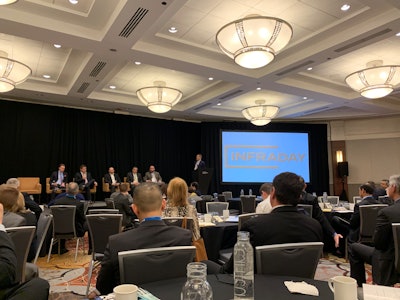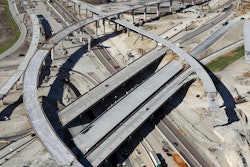
The American Society of Civil Engineers (ASCE) estimates we need to spend over $4.5 trillion by 2025 to improve the state of the country’s roads, bridges, airports and more. With little to no federal money coming in, asset owners are tasked with balancing an aging infrastructure with the need to meet contemporary demand.
It’s no surprise then that there is renewed interest in public-private partnership (P3) projects, where businesses supplement public investment in return for reaping rewards such as tolls and fees. Even the White House suggests using private investments to fund most of its proposed $1.5 trillion in U.S. infrastructure spending package. Despite the concerns contractors have about P3 projects, many infrastructure owners and developers are starting to realize the fact that they're not going to get anything done without a little help.
"There are a lot of things public agencies like cities and states are good at, and a lot of things they're not equipped to deal with," Sabin Yanez, principal at CFSE says. "P3's are designed to help fill those gaps on both large and small projects."
Recently, local, state and federal authorities, along with some of the top financiers, consultants, constructors, engineers and technology innovators were brought together for InfraDay Midwest, a one day forum to discuss new opportunities and challenges facing the market.
Many of these parties from both the public and private side agreed that P3s were becoming the best way to cut through legislative red tape and get projects done in a more timely manner, as long as you have a few key variables in place first.
Understand the Risk
For more than 100 years (in the United States at least), the public and private sector’s roles in the design, construction, financing, operation and maintenance of public infrastructure were well defined: the public sector owns, operates and maintains public infrastructure; it also finances capital improvements for major renovations or new infrastructure. When it comes to delivering large capital projects, the public sector hires qualified architects and engineers to design the projects and then separately hires the construction contractor that submits the best bid to complete the work.
Recently, trends in public finance, design, construction and asset management have shifted, and in the 1990s, the public sector began experimenting with new forms of private sector involvement in public infrastructure. Some governments passed legislation allowing the government to hire one firm to design and construct a project. Done correctly, this improved schedule and budget performance without sacrificing quality. And on some projects, the public would enter into a long-term arrangement for a private company to design, construct, finance, operate and maintain a public asset. An option that is gaining in popularity.
With all that responsibility being outsourced to a private entity, the public agency is assuming a lot of risk in trusting them to get things done. The private entity is also assuming risk that they are going to continually be paid for their services. Therefore, it is important that all parties understand those risks that are involved with P3 projects.
"Because of the risk, P3's are slow to accept because we don't like change, we are a risk-adverse culture," Darcy Frick Stewart vice president of business development with JE Dunn Construction Company says. "However, that is why P3s are a good thing because they allow the public sector to outsource risk to entities that are the experts in things like design-build."
But since the public sector is so risk adverse, they are even more unwilling to advance projects that might fail and make the public entity, like a DOT (department of transportation), look bad.
"When things go wrong on a P3 project, even if the DOT has nothing to do with what's happening, they are going to get the blame," Joe McGuiness, commissioner at Indiana DOT. "If contractors are walking out on a P3 because they're not getting paid and projects are stalled, the public is always going to blame the DOT and not the private entity because they aren't aware of the full situation. So in that way, the public sector is always going to be involved in some way in a P3 and that's what can make them seem unattractive."
Which is exactly why it's imperative that you identify, evaluate and manage various risks that could adversely affect the implementation of the organization's strategy.
"It's very important for public owner to understand the risk of the project," Sam Beydoun, bureau chief, innovative project delivery at the Illinois Department of Transportation (IDOT) says. "There is always a desire on the public side to push the project out, but there’s no benefit to that. If we understand the risk allocation, we are going to have a much more successful project. Make sure you build a risk profile and allocate the risk to the entity that is most capable of handling that risk."
Politicians are also adverse to P3's because of the assumed risk.
"There is always a political reputation at risk, but like it or not we own a piece of infrastructure that is aging and we need to do something about it," Bill Neuendorf, economic development manager for the City of Edina, MN says. "From that aspect they are on board, but politically it’s more challenging to tell them they need to put money at risk in order for these projects to be successful. Elected officials may not like it, but if the risk is shared, they will eventually realize it’s something that needs to be done."
Do the Research
Another theme that came up over an over again throughout the day was the importance of having the right partners on a P3 project.
"Partnership is the key to a P3," Neuendorf says. "You need mutual trust and respect. Trust so that if something goes wrong, the appropriate partner will make it right and respect so that both parties listen to and understand the needs of the project."
That is why many project developers insist on receiving multiple requests for qualifications (RFQ) before the request for proposal (RFP) stage hits.
"You first need to define what are the roles and responsibilities of each partner and how will they be successful in those roles," Beydoun says. "Then invest in research up front to find the right partners and that will save the project money down the road. Sure it takes more money and time for the public agency up front, but it will create better project value delivery in the long run. During the RFQ stage you need to make sure the partner has the right experience for your project, the financial capacity and you need to know if the team has been on projects that have a history of success."
Define Success
Once you choose the right partners, you need to make sure everyone is on board and agrees to what constitutes the project being successful and in what context.
"The private sector is looking at what’s the cheapest cost to build and operate this piece of infrastructure for an extended period of time," Bryan A. Kendro, project development director at Star America Infrastructure Partners says. "The challenge then is getting the contracts right so everyone gets what they want."
Kendro says both parties need to understand their responsibilities when it comes to roadblocks on a project.
"The private sector isn’t any better than the public when dealing with project delays. In fact, the public sector is in a better position of dealing with companies that aren’t in compliance (i.e. permitting and utilities). If the private sector is going to take on those risks, there will be higher pricing to mitigate those delay risks. At the end of the day, contractors may not be making what they think they should on the job if there are delays, but they have to acknowledge that those risks exist and sometimes you have to accept that risk transfer and look through the filter of how success on the project is defined."
Still Beydoun says there are many benefits to a P3 when it comes to successful project completion.
"We are seeing P3 projects delivered on time or early even at IDOT," he says."There are incentives to come in ahead of schedule. It gives the developer more revenue and it makes the public entity look good as well. The public sector is starting to understand that these projects can be done and are being done successfully."
Beydoun says bonus incentives should be clearly defined in contracts in order to mitigate risk and to motivate all parties involved to expedite the project efficiently.
Ohio Leading the Way
Speaking of a successful P3 project, the Southern Ohio Veterans Memorial Highway is a Design Build Finance Operate and Maintain (DBFOM) Public Private Partnership that is Ohio’s first venture into the P3 arena. This 16-mile long, four lane highway through Appalachia is one of the first rural P3s in the country.
A new Portsmouth Bypass has been talked about in Scioto County since the early 1960's. Ohio DOT (ODOT) completed a feasibility study in the early 2000's and in 2013 started the bidding process. But ODOT decided to see if any companies were interested in a P3, given the size and scale of the project.
The $634.3 million project started in 2015 and took 3 ½ years to build. Had the ODOT done the entire project itself, it would have been completed in three phases and only the first phase would have been completed by now. ODOT estimates the P3 allowed the project to be completely finished approximately ten years ahead of schedule. But that timeline is only accurate if ODOT would have been able to secure the funding for additional phases, something they likely would not have been able to do.
“We were only financed through phase one construction,” Kathleen Fuller, ODOT District 9 Spokeswoman says. “With the P3 we were able to take advantage of an independent financing company to come in and basically build the route for us all at once. So we got all three phases built at one time. We can have it opened to traffic all at once rather in phases, and we can shorten the timetable to get the route open to traffic.”
The project itself cost around $450 million but ODOT will pay out roughly $200 million over the next 35 years. The only responsibility ODOT has for the road is clearing snow and ice. The Portsmouth Gateway Group (PGG) will maintain the road over the next several decades as part of the agreement.
"Sure there is risk involved that PGG won't be able to complete the operation and maintenance (O&M) phase of this project," Lloyd MacAdam, P.E., P.S. chief engineer and assistant director for transportation policy at ODOT says. "However, they only have a small piece of the money at this point so that is the incentive for them to stick around and complete O&M for 30 years, but if they walk away that’s the risk that’s assumed."
Still, ODOT is incredibly pleased with the outcome of the P3 and will continue to monitor the success of the project through the O&M phase.
"The traveling public, as well as the community as a whole, gets to enjoy the benefits and advantages of having the route opened all at once instead of phases,” Fuller says.
For more on InfraDay visit www.infraday.com.




















